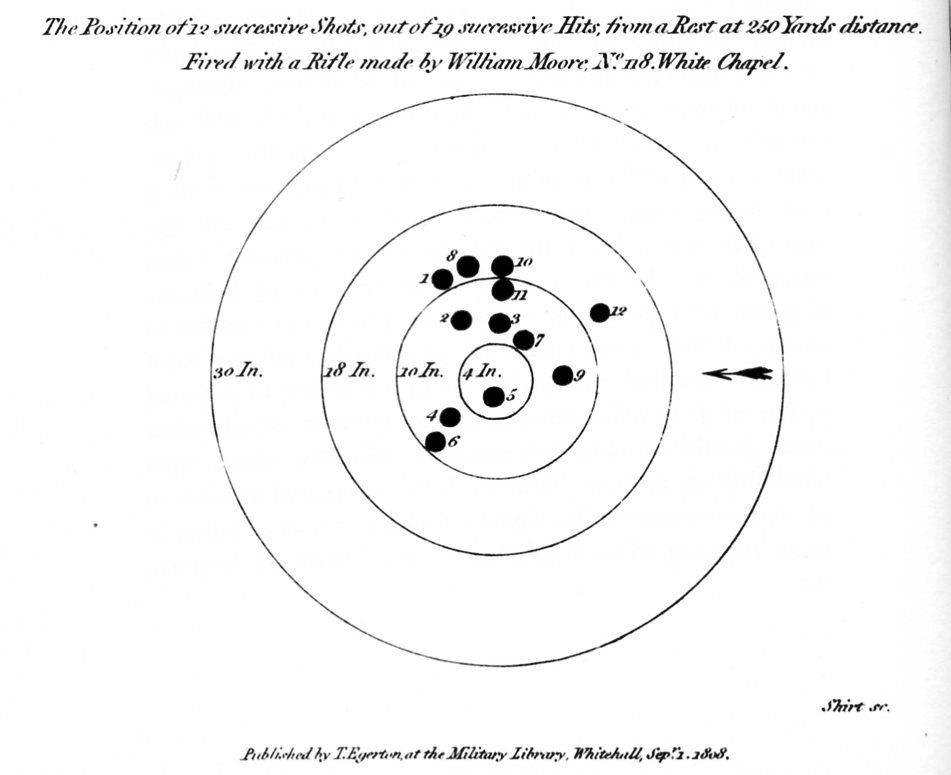Warren Johnson's Journal: 1760-61 [Brother of Sir William Johnson.]
"January the 24th The Weather still soe cold that handling Brass, or Iron leaves a Blister on the Fingers; & in Bed People are cold even with ten Blankets on. They are remarkable at Philadelphia for making rifled Barrell Gunns, which throw a Ball above 300 yards, vastly well, & much better than any other Barrells. People here in general Shoot very well with Ball, but don't doe much with Shot."
******
John Dabney Shane's interview of Benjamin Stites, speaking of the Kentucky frontier in the 1790s:
"He was not more than 150 yards from the fort. Rather out of reach of gunshot at that time."
******
“The Life and times of Gen. Sam Dale, the Mississippi partisan”, by John Francis Hamtramck Claiborne:
At a council of uniformed officers during the Creek War of 1813-14:
“I was a stranger for most of the council and my appearance did not recommend me I was smoke tanned and gaunt from fatigue and protracted anxiety; I wore a hunting shirt of rust brown color, homespun pants, moccasins and leggings of dressed buckskin, and a bearskin cap; a belt of panther skin with my pouch and hunting knife, and a long rifle---good for a hundred yards--- completed my equipment.”
*****
THE VIRGINIA GAZETTE 3
November 17, 1775
Mr. Purdie,
I REMEMBER seeing an account of capt. Cresap's rifle company shooting at a shingle that was held in one of the men's hands, and shot through by his brother. This was mentioned to be a very extraordinary thing, as indeed it was; but it is no more than what has been frequently done by the Virginia riflemen. I have known many people do it. At the distance of 200 yards, two men have shot into the same hole, in a paper not bigger than a dollar; and this Mr. S. Athawes of London can attest, for he saw it done when he was in Frederick county, Virginia, and carried home with him the paper, through which it was but just discernable that two balls had passed. The riflemen now in our regiments declare, that they can hit a man every shoot if within 250 yards, and his head if within 150. As some proof of this, I can mention what happened a little while ago on one of the creeks near Williamsburg. A man had got into a canoe, out of a boat, upon seeing the riflemen, and was paddling off, when they hailed him. On his refusing to stop, they fired ahead of him; and the man still continuing his flight (thinking that by this time he had got out of their reach, as he has since confessed) the officer ordered his people to fire at him, which three of them did, when one shot went through the canoe, another through the man's waistcoat, brushing a button on his breast, and the third through his hat, within half an inch of his head."
*****
Travels Through the States of North America and the Provinces of Upper and Lower Canada, During the Years of 1795, 1796 and 1797", by Isaac Weld, Jr.
"The best rifles are furnished with two triggers, one of which being first pulled sets the other, that is, alters the spring, so that it will yield even to the slight touch of a feather. They are also furnished with double sights along the barrel, as fine as those of a surveying instrument. An experienced marksman, with one of these guns, will hit an object not larger than a crown piece, to a certainty, at the distance of one hundred yards...... A rifle gun will not carry shot, nor will it carry a ball much farther than one hundred yards with certainty."
******
General George Hanger to all Sportsmen, Farmers, and Gamekeepers, 1814
Hanger discusses a book, _Scloppetaria; or, Considerations on the Nature and Use of Rifle-barrel Guns...by a Corporal of Riflemen_, pseudonym of Capt. Henry Beaufoy, the first book in English about target rifle shooting, published 1808. He describes targets shown on copper-plates: “In the lower target, page 119, I find, at the distance of two hundred and fifty yards, that eight shots in twelve are concentrated in the small space of ten inches; to which I beg leave to add two more, for they are absolutely touching the edge of the ten-inch circle. This is shooting with such a degree of precision as I never saw, and I believe will be found very difficult to exceed.”
Here is the target:

Caption above says, "The Position of 12 successive Shots, out of 19 successive Hits, from a Rest at 250 Yards distance. Fired with a Rifle made by William Moore, No. n8, White Chapel."
Caption below says, "Published by T. Egerton at the Military Library, Whitehall, Sept. 1, 1808."
Spence





